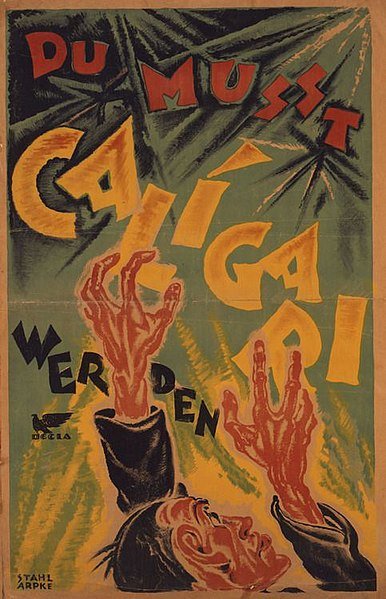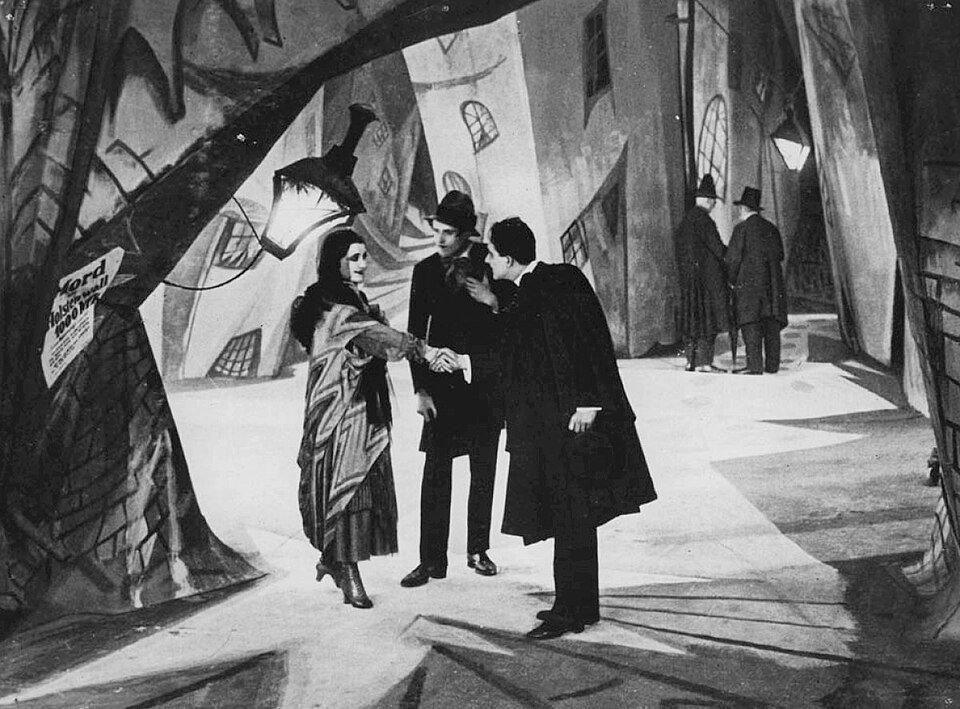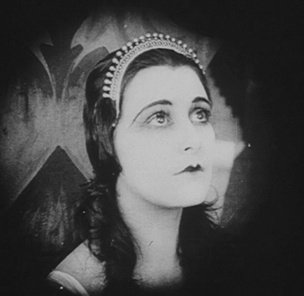
The Cabinet of Dr. Caligari (Das Kabinett des Dr. Caligari)
Germany, 1920
Director: Robert Wiene
Screenplay: Carl Mayer, Hans Janowitz
Main actors:Werner Krauss, Conrad Veidt, Friedrich Feher, Lil Dagover, Hans Heinrich von Twardowski, Rudolf Lettinger
Genre: Mystery, silent films
Plot
Young Franzis chats with a mature gentleman, both seem quite frightened. They talk about ghosts and paranormal matters. At this point a girl crosses their path who seems to be haunted. Franzis comments that she is his girlfriend. And she begins to tell the old man a disturbing story that happened to her some time ago in her hometown…
Franzis went to a kind of fair with his friend Alan. At these street festivities, among other attractions, there was also the show of a strange individual: Dr. Caligari. He presents a very special act with a sleepwalker named Cesare. This Cesare, according to Caligari, is a sleepwalker from birth but can wake up if the doctor orders him to, and is able both to tell what happened in the past (without having been there) and to predict the future.

At the same time, a series of mysterious crimes begin to occur in the town… One of the victims will be precisely Alan, Franzis’ friend. Both, by the way, were in love with the same woman (Jane, the alienated-looking young woman who appears in the first scene).

Franzis sets out to investigate. He suspects Caligari and his sleepwalker, because the latter, in one of the shows, had “prophesied” the death of his friend. But apparently the “magician” and his troupe have an alibi. And an individual is arrested while trying to kill a woman. The authorities also frame him for the crimes that had previously taken place in the town, in order to close the case. But they are wrong to want to close the case so quickly…

Commentary
In 1920, Robert Wiene would direct one of the most emblematic films of German expressionism, which would become a reference and one of the best known films of the silent stage of the seventh art.
The set, unreal and reminiscent of cubism, is quite striking. Other filmmakers would be inspired by this curious mise-en-scene. Dr. Caligari is quite reminiscent of a character that would appear a few years later by the hand of Fritz Lang: Dr. Mabuse (the protagonist of a more or less official trilogy whose success would lead to several sequels). Both Caligari and Mabuse are “mad scientists” and criminal geniuses at the same time. Although in Caligari’s case, things seem to be closer to the supernatural realm.
Most of the film is a flashback of what Franzis, the protagonist, narrates to his companion in the courtyard of the place where they are both confined. To avoid revealing more details of the plot, I will only add that the analogies between Caligari and Mabuse are even greater than they may seem from the outset.
“Caligari”, which is not his real name, is like Mabuse a megalomaniac psychiatrist, who leads a double life. His “secret” identity is that of Caligari, a kind of Italian sorcerer who in the 18th century engaged in human experiments, manipulating the will and consciousness of others, using a sleepwalker named Cesare as a “guinea pig”. The director of a psychiatric center, obsessed with this old legend, decides to emulate his idol by becoming the new Caligari. His desire to exert mental control over others makes him lose his mind.
Obviously, Lang was inspired by the film we are discussing today to make the deliveries of his Mabuse. Caligari’s clothing includes curious white gloves with black stripes, which give a caricatured aspect to his person (and probably have some symbolism that connoisseurs will be able to interpret).

The sets, which we have already mentioned, are reminiscent of a theater stage, you can see that they are made of papier-mâché or wood, and that they have that unreal appearance on purpose, all part of the visual and aesthetic style of the proposal. This dreamlike-futuristic character of the sets (with chairs, doors and tables of impossible shapes) would be imitated in the films of that decade, which belonged to the expressionist current or were influenced by it.
The director Robert Wiene would also film in 1920 “Genuine”, a minor contribution that does not have nearly the same interest as “The Cabinet of Dr. Caligari” (where suspense, mystery and the viewer’s desire to see how the story continues are increasing).
The criminal, arrested as the initial suspect in the murders, is played by Rudolf Klein-Rogge, who would later play Dr. Mabuse and the scientist Rotwang in “Metropolis”.
Get The Cabinet of Dr. Caligari HERE!
(This is an affiliate link. I may earn a commission if you purchase through these link, at no extra cost to you. As an Amazon Associate, I earn from qualifying purchases.)
